Health Workforce in Australia: Government Policies & Analysis
VerifiedAdded on 2023/01/16
|12
|2447
|96
Report
AI Summary
This report provides an overview of the health workforce in Australia, addressing the country's reliance on international health worker immigration. It examines the current government policies, historical reasons for this reliance, and the sustainability of these policies. The report analyzes data on the number of health workers, including medical practitioners, nurses, and midwives, and discusses the impact of immigration on workforce supply. It also explores the reasons behind the increasing dependence on overseas-trained professionals and the challenges associated with this trend, such as the brain drain from low- and middle-income countries. Furthermore, the report assesses the sustainability of current policies and proposes changes the Australian government should consider to reduce the negative effects of health worker migration, including regulating the number of health workers in rural and remote areas and formulating competitive recruitment policies. The report uses data from surveys and reports, including data on the number of immigrant health workers and their countries of origin, to support its arguments and recommendations, providing insights into the complexities of health workforce planning and management in Australia.
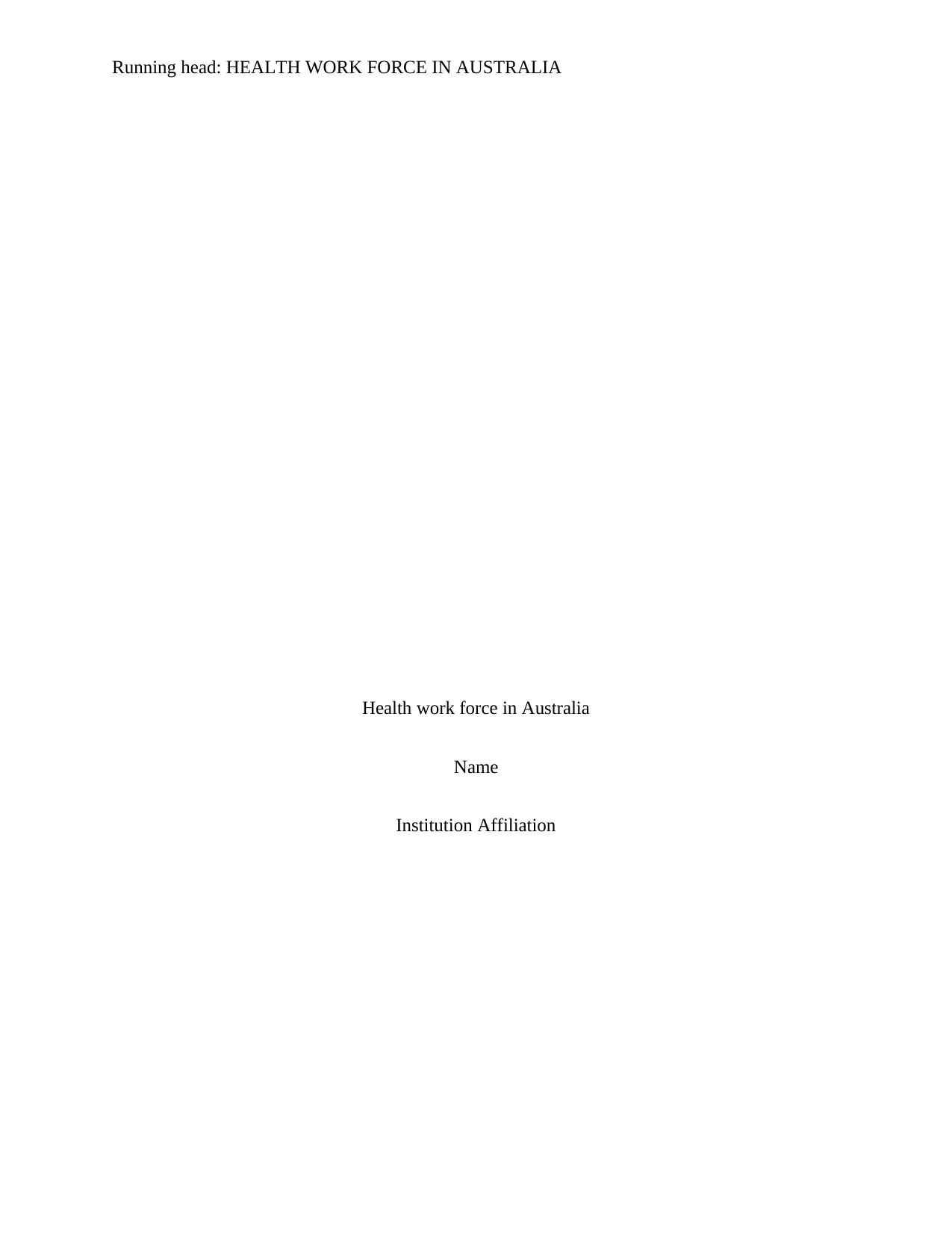
Running head: HEALTH WORK FORCE IN AUSTRALIA
Health work force in Australia
Name
Institution Affiliation
Health work force in Australia
Name
Institution Affiliation
Paraphrase This Document
Need a fresh take? Get an instant paraphrase of this document with our AI Paraphraser
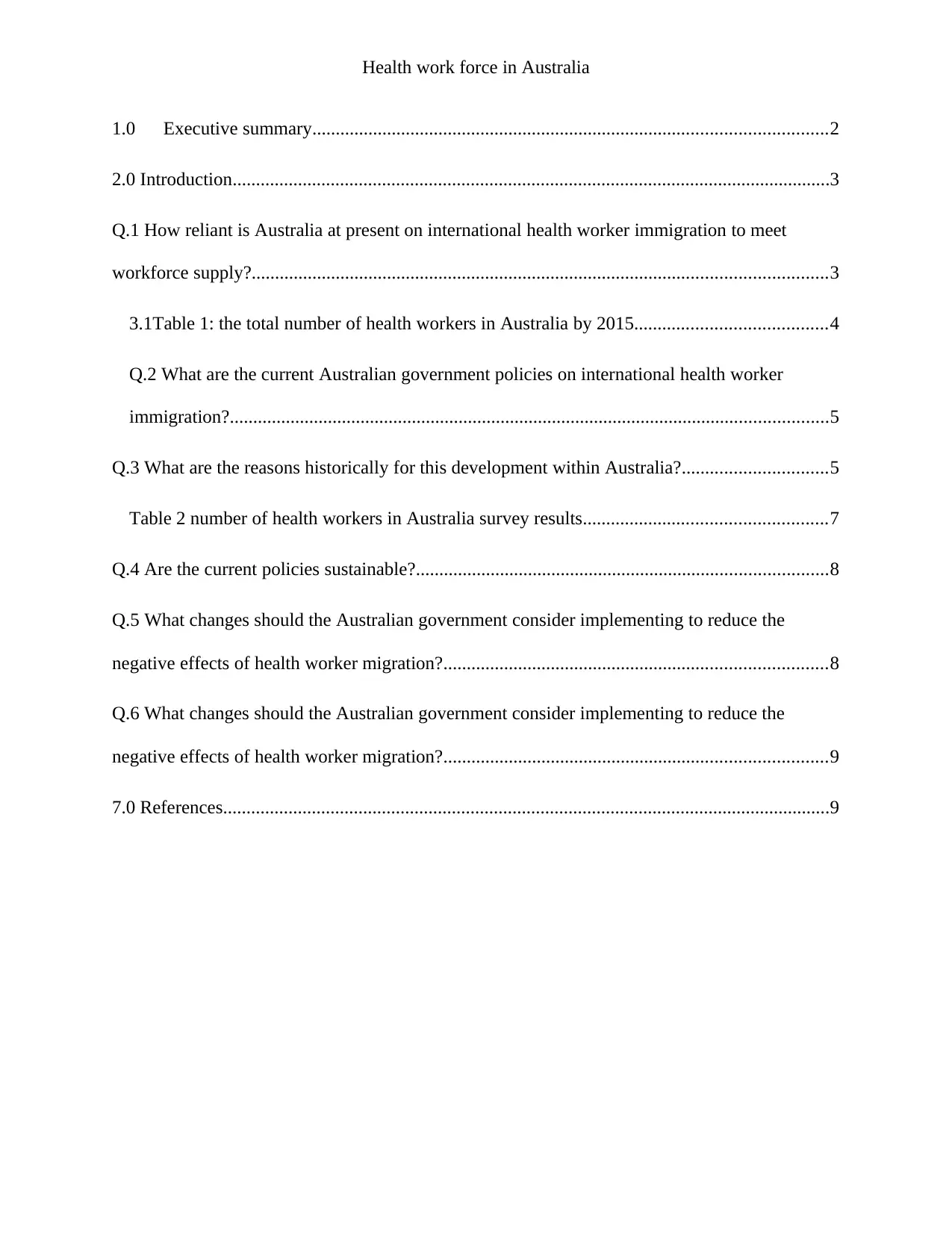
Health work force in Australia
1.0 Executive summary..............................................................................................................2
2.0 Introduction................................................................................................................................3
Q.1 How reliant is Australia at present on international health worker immigration to meet
workforce supply?...........................................................................................................................3
3.1Table 1: the total number of health workers in Australia by 2015.........................................4
Q.2 What are the current Australian government policies on international health worker
immigration?................................................................................................................................5
Q.3 What are the reasons historically for this development within Australia?...............................5
Table 2 number of health workers in Australia survey results....................................................7
Q.4 Are the current policies sustainable?........................................................................................8
Q.5 What changes should the Australian government consider implementing to reduce the
negative effects of health worker migration?..................................................................................8
Q.6 What changes should the Australian government consider implementing to reduce the
negative effects of health worker migration?..................................................................................9
7.0 References..................................................................................................................................9
1.0 Executive summary..............................................................................................................2
2.0 Introduction................................................................................................................................3
Q.1 How reliant is Australia at present on international health worker immigration to meet
workforce supply?...........................................................................................................................3
3.1Table 1: the total number of health workers in Australia by 2015.........................................4
Q.2 What are the current Australian government policies on international health worker
immigration?................................................................................................................................5
Q.3 What are the reasons historically for this development within Australia?...............................5
Table 2 number of health workers in Australia survey results....................................................7
Q.4 Are the current policies sustainable?........................................................................................8
Q.5 What changes should the Australian government consider implementing to reduce the
negative effects of health worker migration?..................................................................................8
Q.6 What changes should the Australian government consider implementing to reduce the
negative effects of health worker migration?..................................................................................9
7.0 References..................................................................................................................................9

Health work force in Australia
1.0 Executive summary
There is a major challenge on the demand of health workforce around the globe which
has triggered a major challenge to meet the demand. This demand has resulted in the recruitment
of qualified health workers from overseas which has continued to raise issues by the WHO. The
main challenge has been due to the brain drain of doctors from LMIc by the high-income
countries due to recruitment demand. Australia is a country that has continued to depend on
immigration of health workers had to strategies on measures to mitigate the challenges of health
workers. This concern was triggered due to WHO measures to regulate the immigration of health
workers across the globe. The Australian government devised measures to regulate the health
workforce by taking a survey which has enabled Australia to regulate health workers and attain
effective and sustainable health workforce in urban and rural and remote areas in Australia.
Today Australia has the highest number of immigrant health workforce working in Australia.
2.0 Introduction
Health workforce planning plays a major key role in ensuring health services is optimal
and effective. To meet the high demand for health services, the planning bodies must ensure
there are sufficient health practitioners to meet the health demand. To maintain the decreasing
numbers of professional and practicing health workers many countries have resulted in
outsourcing doctors from other countries (O’Sullivan, Russell, McGrail, & Scott, 2019). This
result due to many factors some being the lack of sufficient ski ls and labor force. In this case,
we will focus on health planning, reliance on immigration of health workforce and measures of
the increasing workforce in Australia to meet the health demand.
1.0 Executive summary
There is a major challenge on the demand of health workforce around the globe which
has triggered a major challenge to meet the demand. This demand has resulted in the recruitment
of qualified health workers from overseas which has continued to raise issues by the WHO. The
main challenge has been due to the brain drain of doctors from LMIc by the high-income
countries due to recruitment demand. Australia is a country that has continued to depend on
immigration of health workers had to strategies on measures to mitigate the challenges of health
workers. This concern was triggered due to WHO measures to regulate the immigration of health
workers across the globe. The Australian government devised measures to regulate the health
workforce by taking a survey which has enabled Australia to regulate health workers and attain
effective and sustainable health workforce in urban and rural and remote areas in Australia.
Today Australia has the highest number of immigrant health workforce working in Australia.
2.0 Introduction
Health workforce planning plays a major key role in ensuring health services is optimal
and effective. To meet the high demand for health services, the planning bodies must ensure
there are sufficient health practitioners to meet the health demand. To maintain the decreasing
numbers of professional and practicing health workers many countries have resulted in
outsourcing doctors from other countries (O’Sullivan, Russell, McGrail, & Scott, 2019). This
result due to many factors some being the lack of sufficient ski ls and labor force. In this case,
we will focus on health planning, reliance on immigration of health workforce and measures of
the increasing workforce in Australia to meet the health demand.
⊘ This is a preview!⊘
Do you want full access?
Subscribe today to unlock all pages.

Trusted by 1+ million students worldwide
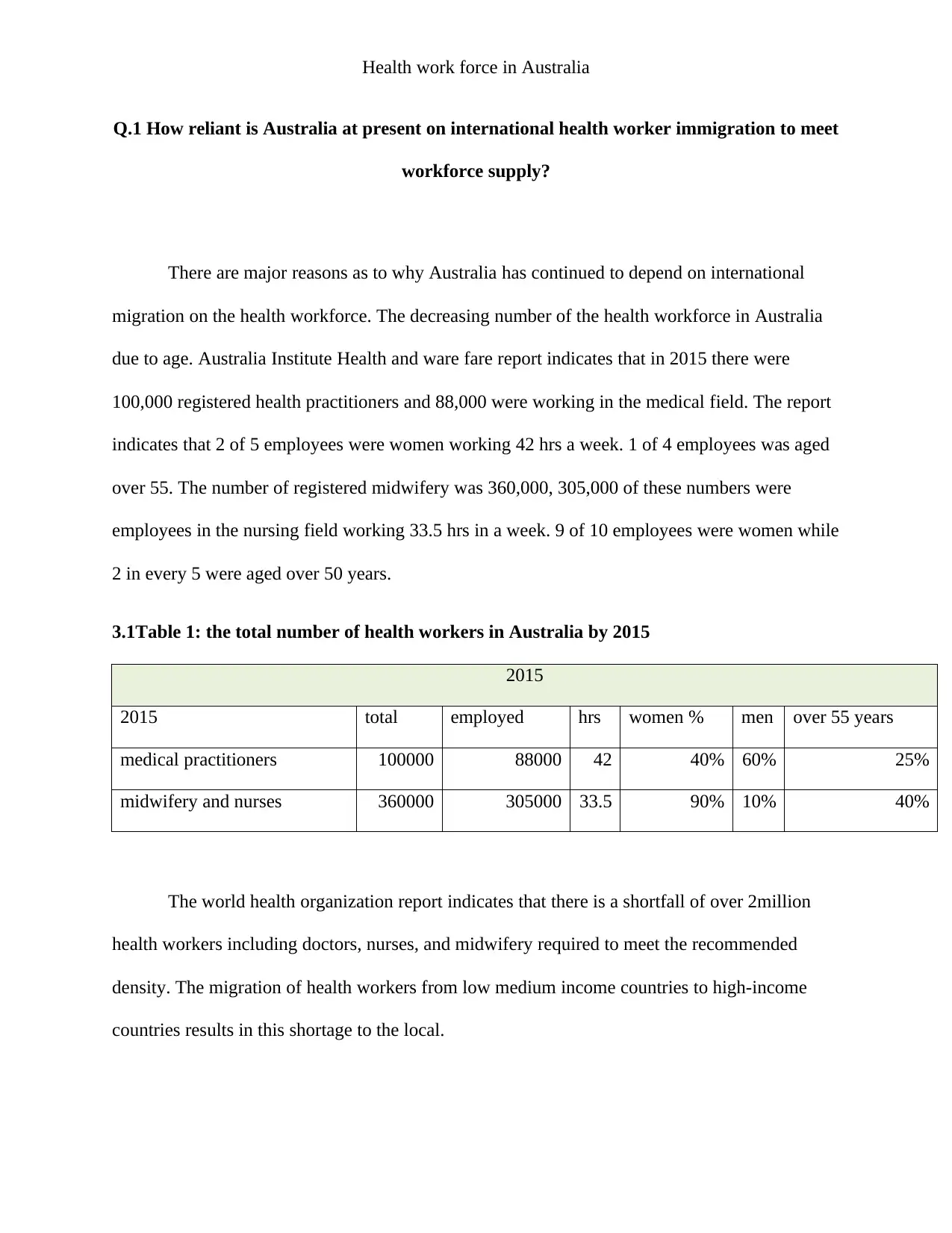
Health work force in Australia
Q.1 How reliant is Australia at present on international health worker immigration to meet
workforce supply?
There are major reasons as to why Australia has continued to depend on international
migration on the health workforce. The decreasing number of the health workforce in Australia
due to age. Australia Institute Health and ware fare report indicates that in 2015 there were
100,000 registered health practitioners and 88,000 were working in the medical field. The report
indicates that 2 of 5 employees were women working 42 hrs a week. 1 of 4 employees was aged
over 55. The number of registered midwifery was 360,000, 305,000 of these numbers were
employees in the nursing field working 33.5 hrs in a week. 9 of 10 employees were women while
2 in every 5 were aged over 50 years.
3.1Table 1: the total number of health workers in Australia by 2015
2015
2015 total employed hrs women % men over 55 years
medical practitioners 100000 88000 42 40% 60% 25%
midwifery and nurses 360000 305000 33.5 90% 10% 40%
The world health organization report indicates that there is a shortfall of over 2million
health workers including doctors, nurses, and midwifery required to meet the recommended
density. The migration of health workers from low medium income countries to high-income
countries results in this shortage to the local.
Q.1 How reliant is Australia at present on international health worker immigration to meet
workforce supply?
There are major reasons as to why Australia has continued to depend on international
migration on the health workforce. The decreasing number of the health workforce in Australia
due to age. Australia Institute Health and ware fare report indicates that in 2015 there were
100,000 registered health practitioners and 88,000 were working in the medical field. The report
indicates that 2 of 5 employees were women working 42 hrs a week. 1 of 4 employees was aged
over 55. The number of registered midwifery was 360,000, 305,000 of these numbers were
employees in the nursing field working 33.5 hrs in a week. 9 of 10 employees were women while
2 in every 5 were aged over 50 years.
3.1Table 1: the total number of health workers in Australia by 2015
2015
2015 total employed hrs women % men over 55 years
medical practitioners 100000 88000 42 40% 60% 25%
midwifery and nurses 360000 305000 33.5 90% 10% 40%
The world health organization report indicates that there is a shortfall of over 2million
health workers including doctors, nurses, and midwifery required to meet the recommended
density. The migration of health workers from low medium income countries to high-income
countries results in this shortage to the local.
Paraphrase This Document
Need a fresh take? Get an instant paraphrase of this document with our AI Paraphraser
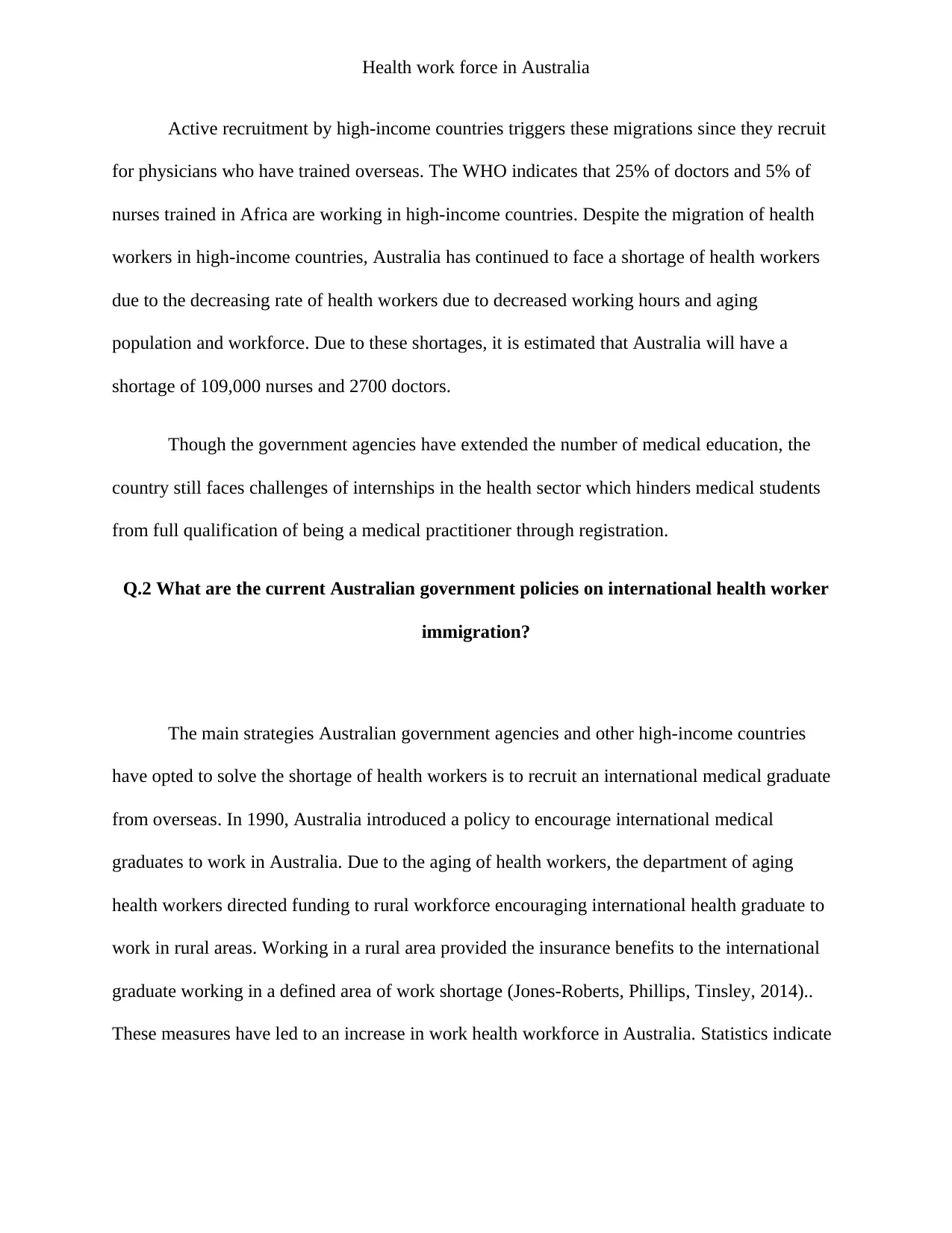
Health work force in Australia
Active recruitment by high-income countries triggers these migrations since they recruit
for physicians who have trained overseas. The WHO indicates that 25% of doctors and 5% of
nurses trained in Africa are working in high-income countries. Despite the migration of health
workers in high-income countries, Australia has continued to face a shortage of health workers
due to the decreasing rate of health workers due to decreased working hours and aging
population and workforce. Due to these shortages, it is estimated that Australia will have a
shortage of 109,000 nurses and 2700 doctors.
Though the government agencies have extended the number of medical education, the
country still faces challenges of internships in the health sector which hinders medical students
from full qualification of being a medical practitioner through registration.
Q.2 What are the current Australian government policies on international health worker
immigration?
The main strategies Australian government agencies and other high-income countries
have opted to solve the shortage of health workers is to recruit an international medical graduate
from overseas. In 1990, Australia introduced a policy to encourage international medical
graduates to work in Australia. Due to the aging of health workers, the department of aging
health workers directed funding to rural workforce encouraging international health graduate to
work in rural areas. Working in a rural area provided the insurance benefits to the international
graduate working in a defined area of work shortage (Jones-Roberts, Phillips, Tinsley, 2014)..
These measures have led to an increase in work health workforce in Australia. Statistics indicate
Active recruitment by high-income countries triggers these migrations since they recruit
for physicians who have trained overseas. The WHO indicates that 25% of doctors and 5% of
nurses trained in Africa are working in high-income countries. Despite the migration of health
workers in high-income countries, Australia has continued to face a shortage of health workers
due to the decreasing rate of health workers due to decreased working hours and aging
population and workforce. Due to these shortages, it is estimated that Australia will have a
shortage of 109,000 nurses and 2700 doctors.
Though the government agencies have extended the number of medical education, the
country still faces challenges of internships in the health sector which hinders medical students
from full qualification of being a medical practitioner through registration.
Q.2 What are the current Australian government policies on international health worker
immigration?
The main strategies Australian government agencies and other high-income countries
have opted to solve the shortage of health workers is to recruit an international medical graduate
from overseas. In 1990, Australia introduced a policy to encourage international medical
graduates to work in Australia. Due to the aging of health workers, the department of aging
health workers directed funding to rural workforce encouraging international health graduate to
work in rural areas. Working in a rural area provided the insurance benefits to the international
graduate working in a defined area of work shortage (Jones-Roberts, Phillips, Tinsley, 2014)..
These measures have led to an increase in work health workforce in Australia. Statistics indicate

Health work force in Australia
that there are 39% of international medical graduates working in Australia and 46% general
practitioners working in remote and rural areas (Axford & Carter, (2015).
Q.3 What are the reasons historically for this development within Australia?
The issues of shortage of health workforce shortage continued to face challenges due to
poorly coordinated skills on migration, to lack of meeting required standards despite the high
reliance on international recruitment of international health professionals, ageing health workers,
lack of sufficient skills due to lack of internship position by health students.
To regulate the international workers' recruitment and brain drain from low middle-income
countries health workers from migrating to high-income countries, the Commonwealth Code of
Practice for the International Recruitment of Health Workers was adopted in 2003. The code
stated the framework on which international recruitment should take place and intended to
discourage recruitment from countries that are facing health workers shortage. Also, the code
indicated how the high-income countries should compensate for the low and middle-income
countries for the recruitment of their workers.
Another hurdle that the Australian government had to handle is the medical school
consideration for migrants. The government from LMIc spends less to educate the medics in
Australia than they would have in their countries. With this strategy, the Australian government
that there are 39% of international medical graduates working in Australia and 46% general
practitioners working in remote and rural areas (Axford & Carter, (2015).
Q.3 What are the reasons historically for this development within Australia?
The issues of shortage of health workforce shortage continued to face challenges due to
poorly coordinated skills on migration, to lack of meeting required standards despite the high
reliance on international recruitment of international health professionals, ageing health workers,
lack of sufficient skills due to lack of internship position by health students.
To regulate the international workers' recruitment and brain drain from low middle-income
countries health workers from migrating to high-income countries, the Commonwealth Code of
Practice for the International Recruitment of Health Workers was adopted in 2003. The code
stated the framework on which international recruitment should take place and intended to
discourage recruitment from countries that are facing health workers shortage. Also, the code
indicated how the high-income countries should compensate for the low and middle-income
countries for the recruitment of their workers.
Another hurdle that the Australian government had to handle is the medical school
consideration for migrants. The government from LMIc spends less to educate the medics in
Australia than they would have in their countries. With this strategy, the Australian government
⊘ This is a preview!⊘
Do you want full access?
Subscribe today to unlock all pages.

Trusted by 1+ million students worldwide
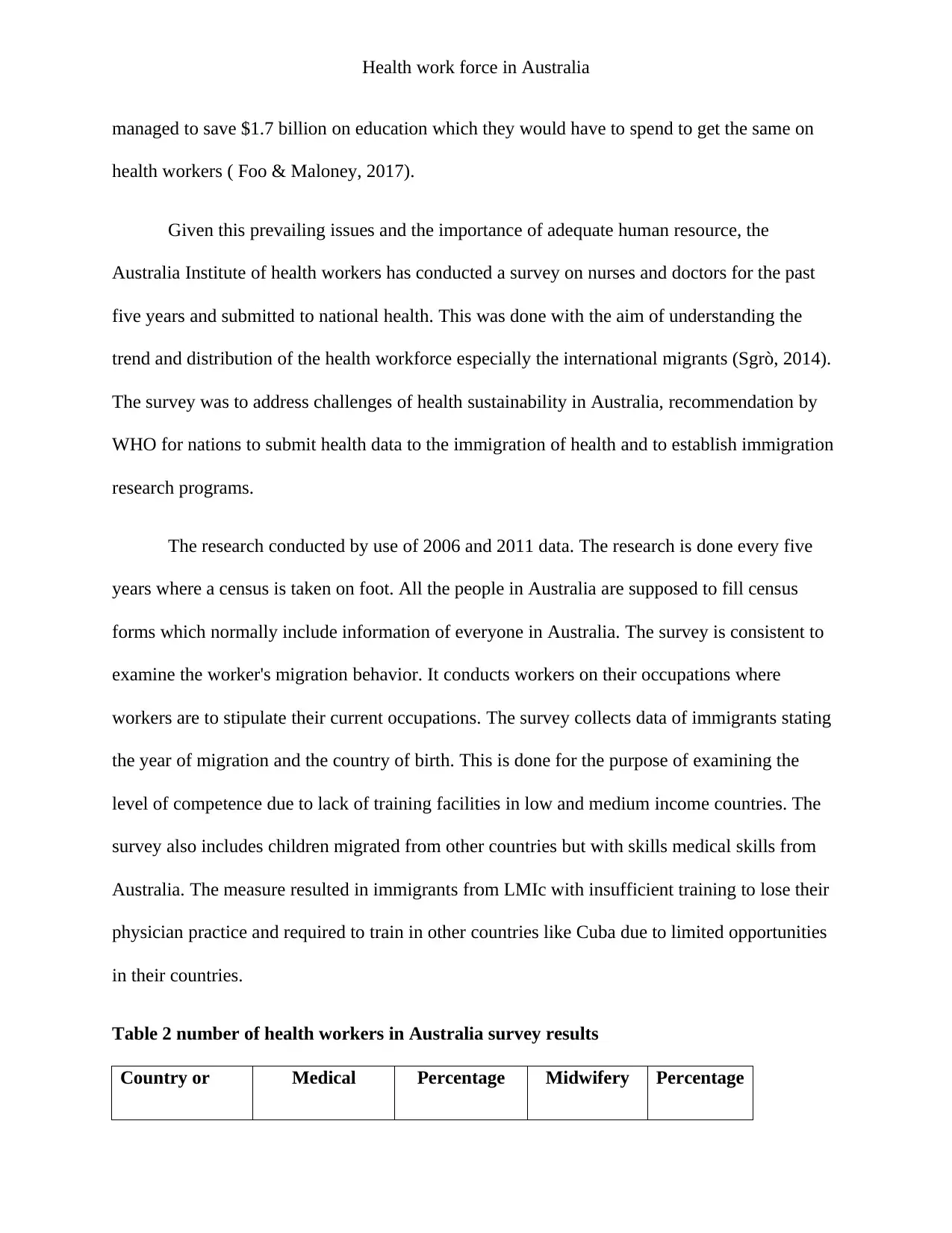
Health work force in Australia
managed to save $1.7 billion on education which they would have to spend to get the same on
health workers ( Foo & Maloney, 2017).
Given this prevailing issues and the importance of adequate human resource, the
Australia Institute of health workers has conducted a survey on nurses and doctors for the past
five years and submitted to national health. This was done with the aim of understanding the
trend and distribution of the health workforce especially the international migrants (Sgrò, 2014).
The survey was to address challenges of health sustainability in Australia, recommendation by
WHO for nations to submit health data to the immigration of health and to establish immigration
research programs.
The research conducted by use of 2006 and 2011 data. The research is done every five
years where a census is taken on foot. All the people in Australia are supposed to fill census
forms which normally include information of everyone in Australia. The survey is consistent to
examine the worker's migration behavior. It conducts workers on their occupations where
workers are to stipulate their current occupations. The survey collects data of immigrants stating
the year of migration and the country of birth. This is done for the purpose of examining the
level of competence due to lack of training facilities in low and medium income countries. The
survey also includes children migrated from other countries but with skills medical skills from
Australia. The measure resulted in immigrants from LMIc with insufficient training to lose their
physician practice and required to train in other countries like Cuba due to limited opportunities
in their countries.
Table 2 number of health workers in Australia survey results
Country or Medical Percentage Midwifery Percentage
managed to save $1.7 billion on education which they would have to spend to get the same on
health workers ( Foo & Maloney, 2017).
Given this prevailing issues and the importance of adequate human resource, the
Australia Institute of health workers has conducted a survey on nurses and doctors for the past
five years and submitted to national health. This was done with the aim of understanding the
trend and distribution of the health workforce especially the international migrants (Sgrò, 2014).
The survey was to address challenges of health sustainability in Australia, recommendation by
WHO for nations to submit health data to the immigration of health and to establish immigration
research programs.
The research conducted by use of 2006 and 2011 data. The research is done every five
years where a census is taken on foot. All the people in Australia are supposed to fill census
forms which normally include information of everyone in Australia. The survey is consistent to
examine the worker's migration behavior. It conducts workers on their occupations where
workers are to stipulate their current occupations. The survey collects data of immigrants stating
the year of migration and the country of birth. This is done for the purpose of examining the
level of competence due to lack of training facilities in low and medium income countries. The
survey also includes children migrated from other countries but with skills medical skills from
Australia. The measure resulted in immigrants from LMIc with insufficient training to lose their
physician practice and required to train in other countries like Cuba due to limited opportunities
in their countries.
Table 2 number of health workers in Australia survey results
Country or Medical Percentage Midwifery Percentage
Paraphrase This Document
Need a fresh take? Get an instant paraphrase of this document with our AI Paraphraser

Health work force in Australia
region of birth practitioners and nursing
professional
s
Australia 32,919 47.30% 157,911 66.80%
South Asia 8,155 11.70% 8,339 3.50%
Southeast Asia 6,528 9.40% 13,291 5.60%
United
Kingdom and
Ireland 6,328 9.10% 23,052 9.80%
Sub-Saharan
Africa 3,211 4.60% 6,719 2.80%
Northeast Asia 2,988 4.30% 6,534 2.80%
North Africa
and Middle East
2,655 3.80% 1,098 0.50%
region of birth practitioners and nursing
professional
s
Australia 32,919 47.30% 157,911 66.80%
South Asia 8,155 11.70% 8,339 3.50%
Southeast Asia 6,528 9.40% 13,291 5.60%
United
Kingdom and
Ireland 6,328 9.10% 23,052 9.80%
Sub-Saharan
Africa 3,211 4.60% 6,719 2.80%
Northeast Asia 2,988 4.30% 6,534 2.80%
North Africa
and Middle East
2,655 3.80% 1,098 0.50%
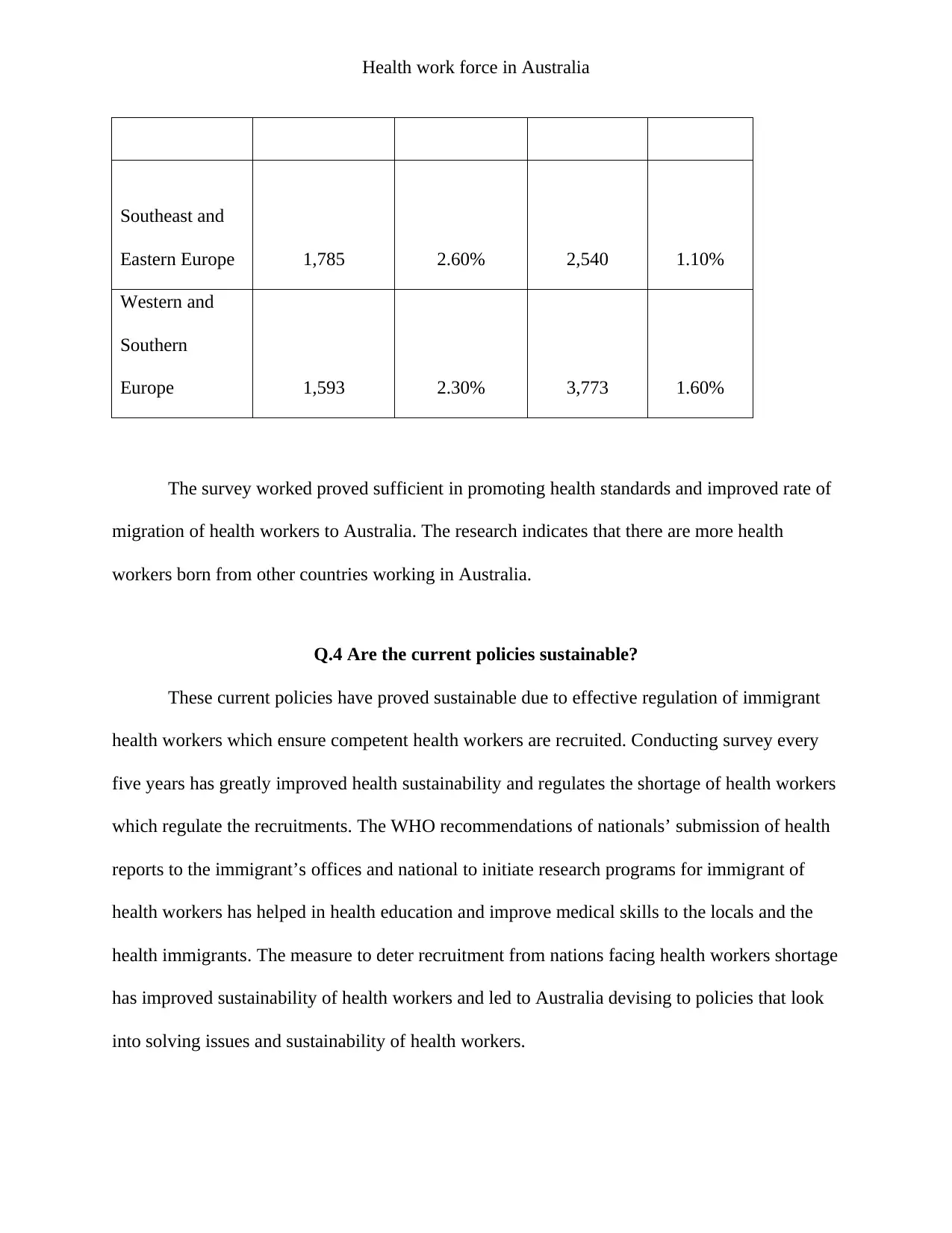
Health work force in Australia
Southeast and
Eastern Europe 1,785 2.60% 2,540 1.10%
Western and
Southern
Europe 1,593 2.30% 3,773 1.60%
The survey worked proved sufficient in promoting health standards and improved rate of
migration of health workers to Australia. The research indicates that there are more health
workers born from other countries working in Australia.
Q.4 Are the current policies sustainable?
These current policies have proved sustainable due to effective regulation of immigrant
health workers which ensure competent health workers are recruited. Conducting survey every
five years has greatly improved health sustainability and regulates the shortage of health workers
which regulate the recruitments. The WHO recommendations of nationals’ submission of health
reports to the immigrant’s offices and national to initiate research programs for immigrant of
health workers has helped in health education and improve medical skills to the locals and the
health immigrants. The measure to deter recruitment from nations facing health workers shortage
has improved sustainability of health workers and led to Australia devising to policies that look
into solving issues and sustainability of health workers.
Southeast and
Eastern Europe 1,785 2.60% 2,540 1.10%
Western and
Southern
Europe 1,593 2.30% 3,773 1.60%
The survey worked proved sufficient in promoting health standards and improved rate of
migration of health workers to Australia. The research indicates that there are more health
workers born from other countries working in Australia.
Q.4 Are the current policies sustainable?
These current policies have proved sustainable due to effective regulation of immigrant
health workers which ensure competent health workers are recruited. Conducting survey every
five years has greatly improved health sustainability and regulates the shortage of health workers
which regulate the recruitments. The WHO recommendations of nationals’ submission of health
reports to the immigrant’s offices and national to initiate research programs for immigrant of
health workers has helped in health education and improve medical skills to the locals and the
health immigrants. The measure to deter recruitment from nations facing health workers shortage
has improved sustainability of health workers and led to Australia devising to policies that look
into solving issues and sustainability of health workers.
⊘ This is a preview!⊘
Do you want full access?
Subscribe today to unlock all pages.

Trusted by 1+ million students worldwide
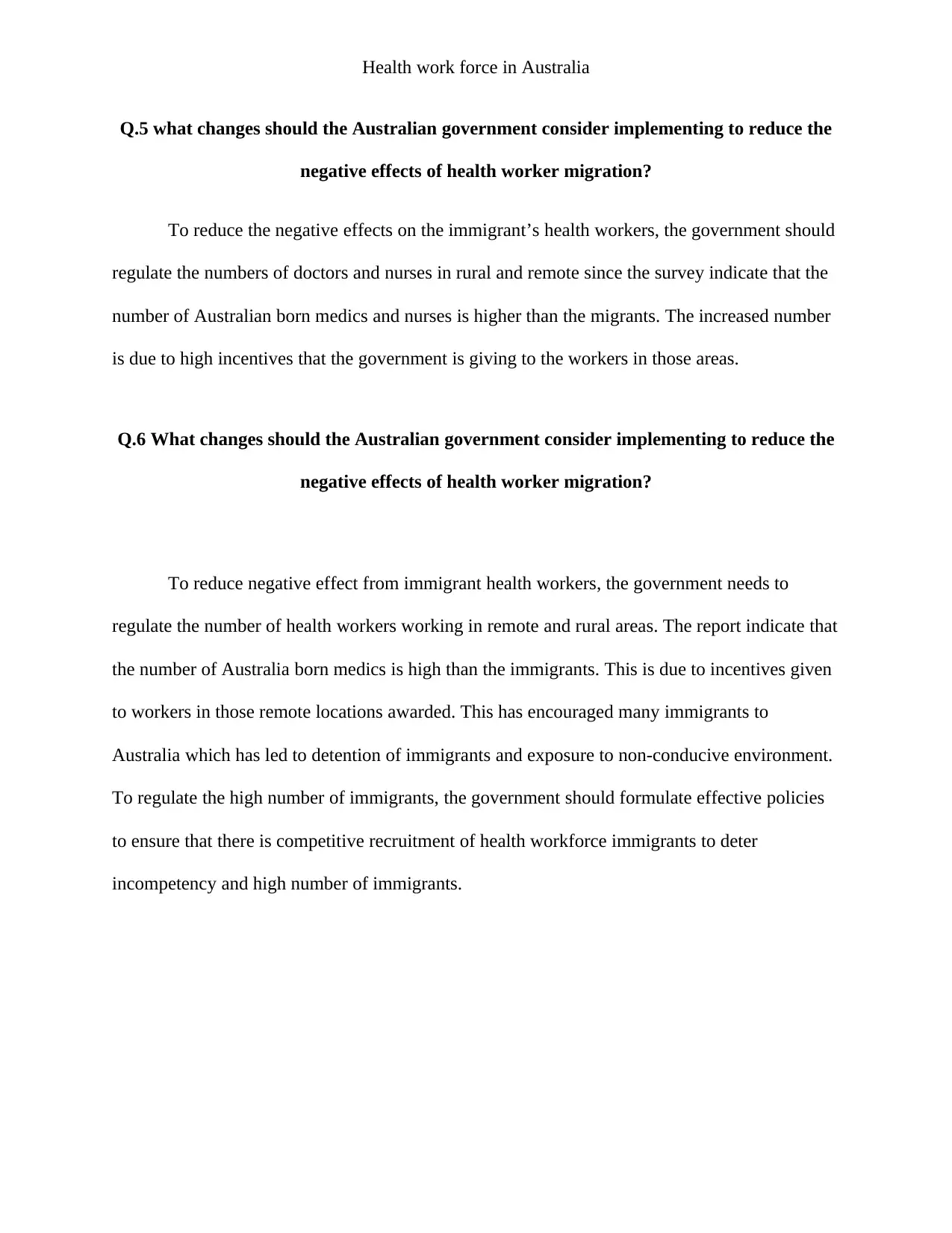
Health work force in Australia
Q.5 what changes should the Australian government consider implementing to reduce the
negative effects of health worker migration?
To reduce the negative effects on the immigrant’s health workers, the government should
regulate the numbers of doctors and nurses in rural and remote since the survey indicate that the
number of Australian born medics and nurses is higher than the migrants. The increased number
is due to high incentives that the government is giving to the workers in those areas.
Q.6 What changes should the Australian government consider implementing to reduce the
negative effects of health worker migration?
To reduce negative effect from immigrant health workers, the government needs to
regulate the number of health workers working in remote and rural areas. The report indicate that
the number of Australia born medics is high than the immigrants. This is due to incentives given
to workers in those remote locations awarded. This has encouraged many immigrants to
Australia which has led to detention of immigrants and exposure to non-conducive environment.
To regulate the high number of immigrants, the government should formulate effective policies
to ensure that there is competitive recruitment of health workforce immigrants to deter
incompetency and high number of immigrants.
Q.5 what changes should the Australian government consider implementing to reduce the
negative effects of health worker migration?
To reduce the negative effects on the immigrant’s health workers, the government should
regulate the numbers of doctors and nurses in rural and remote since the survey indicate that the
number of Australian born medics and nurses is higher than the migrants. The increased number
is due to high incentives that the government is giving to the workers in those areas.
Q.6 What changes should the Australian government consider implementing to reduce the
negative effects of health worker migration?
To reduce negative effect from immigrant health workers, the government needs to
regulate the number of health workers working in remote and rural areas. The report indicate that
the number of Australia born medics is high than the immigrants. This is due to incentives given
to workers in those remote locations awarded. This has encouraged many immigrants to
Australia which has led to detention of immigrants and exposure to non-conducive environment.
To regulate the high number of immigrants, the government should formulate effective policies
to ensure that there is competitive recruitment of health workforce immigrants to deter
incompetency and high number of immigrants.
Paraphrase This Document
Need a fresh take? Get an instant paraphrase of this document with our AI Paraphraser

Health work force in Australia
7.0 References
Axford, A., & Carter, D. (2015). Building workforce capacity for ethical reflection in health
promotion: a practitioner's experience. Health Promotion Journal Of Australia, 26(3), 222-230.
doi: 10.1071/he15031
Foo, J., & Maloney, S. (2017). Costs of training health professionals – a cost to whom? Response
to: The real cost of training health professionals in Australia: it costs as much to build a dietician
workforce as a dental workforce DOI: 10.1177/1355819616668202. Journal Of Health Services
Research & Policy, 135581961771566. doi: 10.1177/1355819617715660
Health workforce - Migration. (2019). Retrieved from https://www.who.int/hrh/migration/en/
Jones-Roberts, A., Phillips, J., & Tinsley, K. (2014). Creating a sustainable health promotion
workforce in Australia: a health promoting approach to professionalisation. Health Promotion
Journal Of Australia, 25(2), 150-152. doi: 10.1071/he13076
O’Sullivan, B., Russell, D., McGrail, M., & Scott, A. (2019). Reviewing reliance on overseas-
trained doctors in rural Australia and planning for self-sufficiency: applying 10 years' MABEL
evidence. Human Resources For Health, 17(1). doi: 10.1186/s12960-018-0339-z
Priddis, L., Matacz, R., & Weatherston, D. (2015). BUILDING A WORKFORCE
COMPETENCY-BASED TRAINING PROGRAM IN INFANT/EARLY CHILDHOOD
MENTAL HEALTH. Infant Mental Health Journal, 36(6), 623-631. doi: 10.1002/imhj.21535
7.0 References
Axford, A., & Carter, D. (2015). Building workforce capacity for ethical reflection in health
promotion: a practitioner's experience. Health Promotion Journal Of Australia, 26(3), 222-230.
doi: 10.1071/he15031
Foo, J., & Maloney, S. (2017). Costs of training health professionals – a cost to whom? Response
to: The real cost of training health professionals in Australia: it costs as much to build a dietician
workforce as a dental workforce DOI: 10.1177/1355819616668202. Journal Of Health Services
Research & Policy, 135581961771566. doi: 10.1177/1355819617715660
Health workforce - Migration. (2019). Retrieved from https://www.who.int/hrh/migration/en/
Jones-Roberts, A., Phillips, J., & Tinsley, K. (2014). Creating a sustainable health promotion
workforce in Australia: a health promoting approach to professionalisation. Health Promotion
Journal Of Australia, 25(2), 150-152. doi: 10.1071/he13076
O’Sullivan, B., Russell, D., McGrail, M., & Scott, A. (2019). Reviewing reliance on overseas-
trained doctors in rural Australia and planning for self-sufficiency: applying 10 years' MABEL
evidence. Human Resources For Health, 17(1). doi: 10.1186/s12960-018-0339-z
Priddis, L., Matacz, R., & Weatherston, D. (2015). BUILDING A WORKFORCE
COMPETENCY-BASED TRAINING PROGRAM IN INFANT/EARLY CHILDHOOD
MENTAL HEALTH. Infant Mental Health Journal, 36(6), 623-631. doi: 10.1002/imhj.21535
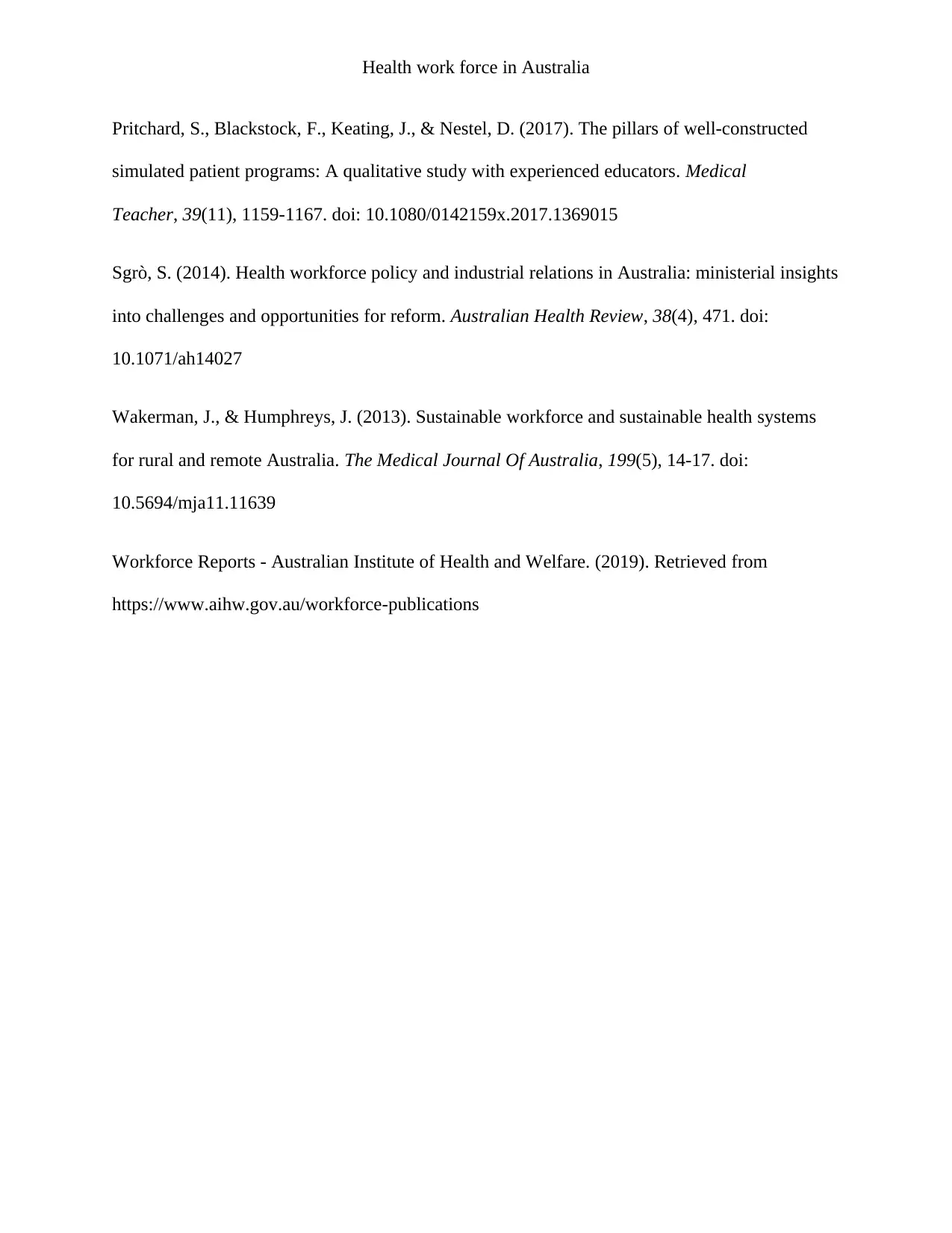
Health work force in Australia
Pritchard, S., Blackstock, F., Keating, J., & Nestel, D. (2017). The pillars of well-constructed
simulated patient programs: A qualitative study with experienced educators. Medical
Teacher, 39(11), 1159-1167. doi: 10.1080/0142159x.2017.1369015
Sgrò, S. (2014). Health workforce policy and industrial relations in Australia: ministerial insights
into challenges and opportunities for reform. Australian Health Review, 38(4), 471. doi:
10.1071/ah14027
Wakerman, J., & Humphreys, J. (2013). Sustainable workforce and sustainable health systems
for rural and remote Australia. The Medical Journal Of Australia, 199(5), 14-17. doi:
10.5694/mja11.11639
Workforce Reports - Australian Institute of Health and Welfare. (2019). Retrieved from
https://www.aihw.gov.au/workforce-publications
Pritchard, S., Blackstock, F., Keating, J., & Nestel, D. (2017). The pillars of well-constructed
simulated patient programs: A qualitative study with experienced educators. Medical
Teacher, 39(11), 1159-1167. doi: 10.1080/0142159x.2017.1369015
Sgrò, S. (2014). Health workforce policy and industrial relations in Australia: ministerial insights
into challenges and opportunities for reform. Australian Health Review, 38(4), 471. doi:
10.1071/ah14027
Wakerman, J., & Humphreys, J. (2013). Sustainable workforce and sustainable health systems
for rural and remote Australia. The Medical Journal Of Australia, 199(5), 14-17. doi:
10.5694/mja11.11639
Workforce Reports - Australian Institute of Health and Welfare. (2019). Retrieved from
https://www.aihw.gov.au/workforce-publications
⊘ This is a preview!⊘
Do you want full access?
Subscribe today to unlock all pages.

Trusted by 1+ million students worldwide
1 out of 12
Related Documents
Your All-in-One AI-Powered Toolkit for Academic Success.
+13062052269
info@desklib.com
Available 24*7 on WhatsApp / Email
![[object Object]](/_next/static/media/star-bottom.7253800d.svg)
Unlock your academic potential
Copyright © 2020–2025 A2Z Services. All Rights Reserved. Developed and managed by ZUCOL.





